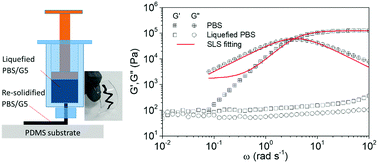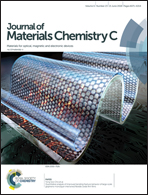A self-healing, adaptive and conductive polymer composite ink for 3D printing of gas sensors†
Abstract
A self-healing conductive polymer composite ink was formulated for 3D extrusion printing of flexible electronics. It was composed of a polyborosiloxane (PBS) matrix and 5 vol% of electrochemically exfoliated graphene. The printability was derived from the chemical-activated mechanically adaptive properties (MAPs) of PBS. The MAPs of PBS and the composite ink were studied through rheological measurements, and the non-Newtonian nature was analyzed using the Carreau–Yasuda model. With methanol vapor as a representative stimulus, the underpinning mechanism of the MAPs of PBS, which involved the methanol-induced alcoholysis of the cross-linking boron/oxygen dative bonds in PBS, was further investigated by infrared spectroscopy. The self-healing, adaptive and conductive composite ink could be used to print 3D structures and devices on a common polydimethylsiloxane flexible substrate. A 3D-printed gas sensor with responses to various chemical vapors was demonstrated as a potential application of this novel composite ink.



 Please wait while we load your content...
Please wait while we load your content...